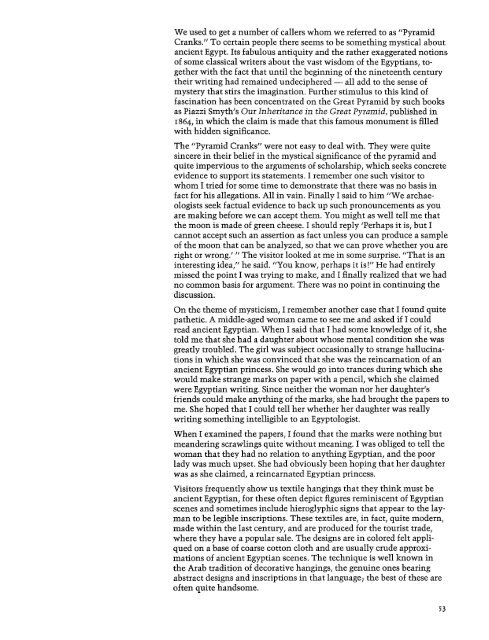Dows Dunham Recollections of an Egyptologist
Create successful ePaper yourself
Turn your PDF publications into a flip-book with our unique Google optimized e-Paper software.
We used to get a number <strong>of</strong> callers whom we referred to as “Pyramid<br />
Cr<strong>an</strong>ks.” To certain people there seems to be something mystical about<br />
<strong>an</strong>cient Egypt. Its fabulous <strong>an</strong>tiquity <strong>an</strong>d the rather exaggerated notions<br />
<strong>of</strong> some classical writers about the vast wisdom <strong>of</strong> the Egypti<strong>an</strong>s, together<br />
with the fact that until the beginning <strong>of</strong> the nineteenth century<br />
their writing had remained undeciphered - all add to the sense <strong>of</strong><br />
mystery that stirs the imagination. Further stimulus to this kind <strong>of</strong><br />
fascination has been concentrated on the Great Pyramid by such books<br />
as Piazzi Smyth’s Our Inherit<strong>an</strong>ce in the Great Pyramid, published in<br />
1864, in which the claim is made that this famous monument is filled<br />
with hidden signific<strong>an</strong>ce.<br />
The “Pyramid Cr<strong>an</strong>ks” were not easy to deal with. They were quite<br />
sincere in their belief in the mystical signific<strong>an</strong>ce <strong>of</strong> the pyramid <strong>an</strong>d<br />
quite impervious to the arguments <strong>of</strong> scholarship, which seeks concrete<br />
evidence to support its statements. I remember one such visitor to<br />
whom I tried for some time to demonstrate that there was no basis in<br />
fact for his allegations. All in vain. Finally I said to him “We archaeologists<br />
seek factual evidence to back up such pronouncements as you<br />
are making before we c<strong>an</strong> accept them. You might as well tell me that<br />
the moon is made <strong>of</strong> green cheese. I should reply ’Perhaps it is, but I<br />
c<strong>an</strong>not accept such <strong>an</strong> assertion as fact unless you c<strong>an</strong> produce a sample<br />
<strong>of</strong> the moon that c<strong>an</strong> be <strong>an</strong>alyzed, so that we c<strong>an</strong> prove whether you are<br />
right or wrong.’ ” The visitor looked at me in some surprise. “That is <strong>an</strong><br />
interesting idea,” he said. “You know, perhaps it is!” He had entirely<br />
missed the point I was trying to make, <strong>an</strong>d I finally realized that we had<br />
no common basis for argument. There was no point in continuing the<br />
discussion.<br />
On the theme <strong>of</strong> mysticism, I remember <strong>an</strong>other case that I found quite<br />
pathetic. A middle-aged wom<strong>an</strong> came to see me <strong>an</strong>d asked if I could<br />
read <strong>an</strong>cient Egypti<strong>an</strong>. When I said that I had some knowledge <strong>of</strong> it, she<br />
told me that she had a daughter about whose mental condition she was<br />
greatly troubled. The girl was subject occasionally to str<strong>an</strong>ge hallucinations<br />
in which she was convinced that she was the reincarnation <strong>of</strong> <strong>an</strong><br />
<strong>an</strong>cient Egypti<strong>an</strong> princess. She would go into tr<strong>an</strong>ces during which she<br />
would make str<strong>an</strong>ge marks on paper with a pencil, which she claimed<br />
were Egypti<strong>an</strong> writing. Since neither the wom<strong>an</strong> nor her daughter’s<br />
friends could make <strong>an</strong>ything <strong>of</strong> the marks, she had brought the papers to<br />
me. She hoped that I could tell her whether her daughter was really<br />
writing something intelligible to <strong>an</strong> <strong>Egyptologist</strong>.<br />
When I examined the papers, I found that the marks were nothing but<br />
me<strong>an</strong>dering scrawlings quite without me<strong>an</strong>ing. I was obliged to tell the<br />
wom<strong>an</strong> that they had no relation to <strong>an</strong>ything Egypti<strong>an</strong>, <strong>an</strong>d the poor<br />
lady was much upset. She had obviously been hoping that her daughter<br />
was as she claimed, a reincarnated Egypti<strong>an</strong> princess.<br />
Visitors frequently show us textile h<strong>an</strong>gings that they think must be<br />
<strong>an</strong>cient Egypti<strong>an</strong>, for these <strong>of</strong>ten depict figures reminiscent <strong>of</strong> Egypti<strong>an</strong><br />
scenes <strong>an</strong>d sometimes include hieroglyphic signs that appear to the laym<strong>an</strong><br />
to be legible inscriptions. These textiles are, in fact, quite modern,<br />
made within the last century, <strong>an</strong>d are produced for the tourist trade,<br />
where they have a popular sale. The designs are in colored felt appliqued<br />
on a base <strong>of</strong> coarse cotton cloth <strong>an</strong>d are usually crude approximations<br />
<strong>of</strong> <strong>an</strong>cient Egypti<strong>an</strong> scenes. The technique is well known in<br />
the Arab tradition <strong>of</strong> decorative h<strong>an</strong>gings, the genuine ones bearing<br />
abstract designs <strong>an</strong>d inscriptions in that l<strong>an</strong>guage; the best <strong>of</strong> these are<br />
<strong>of</strong>ten quite h<strong>an</strong>dsome.<br />
53

















